
Looking for How to Freeze Mangos at Home in 2025? Scroll down this page and follow the links. And if you bring home some fruit or vegetables and want to can, freeze, make jam, salsa or pickles, see this page for simple, reliable, illustrated canning, freezing or preserving directions. There are plenty of other related resources, click on the resources dropdown above. If you are having a hard time finding canning lids, I've used these, and they're a great price & ship in 2 days.
If you have questions or feedback, please let me know! There are affiliate links on this page. Read our disclosure policy to learn more.
Freezing Mangos for Home Storage
Mangos can be easily frozen for use later. You can freeze them in a syrup, dry or puree them and freeze the puree. Here's how to freeze the Mangos, in easy steps:
Directions
Step 1 - Selecting the mangoes
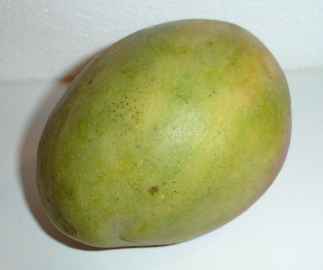 Choose ripe, mature fruit of ideal quality for eating fresh or
cooking. They should not be mushy, but they also should not be rock hard: just as ripe as you would eat them fresh. You can also use solid green
mangoes. Select firm, non-fibrous fruit.
Caution: Handling green mangoes may irritate the skin of some people in the same way as poison ivy. (They belong to the same plant family.)
(see
this page for more information) To avoid this reaction, wear plastic gloves while working with raw green mango. Do not touch your face, lips or eyes
after touching or cutting green mangoes until all traces are washed away .
Choose ripe, mature fruit of ideal quality for eating fresh or
cooking. They should not be mushy, but they also should not be rock hard: just as ripe as you would eat them fresh. You can also use solid green
mangoes. Select firm, non-fibrous fruit.
Caution: Handling green mangoes may irritate the skin of some people in the same way as poison ivy. (They belong to the same plant family.)
(see
this page for more information) To avoid this reaction, wear plastic gloves while working with raw green mango. Do not touch your face, lips or eyes
after touching or cutting green mangoes until all traces are washed away .
Step 2 - How many mangoes and where to get them
You can pick your own, or buy them at the grocery store in the summer months. But for large quantities, you will find that Costco, Sam's Club and BJ's seem to have the largest mangoes and best prices.
It takes about 5 good sized mangoes to fill one quart jar.
* - not the cutesy, fake farmer's markets that are just warehouse grocery stores that call themselves farmer's markets.
Step 3 - Prepare the sugar (or other sweetener) solution
Mangoes may be packed in a syrup or dry: It's up to you which to use. Sugar is added to improve flavor, help stabilize color, and retain the shape of the fruit. It is not added as a preservative. Sugar solution is much less expensive (unless you have a supply of cheap grape juice), so I usually use a light or medium solution to keep sugar (and the added calories) to a minimum. A medium syrup is what the USDA recommends.
A Syrup Pack is preferred for mangos to be used for uncooked desserts or fruit cocktail. A dry pack is good for pie making. The dry pack can be used any way. The syrup pack methods are less likely to brown or have freezer burn. Arrange slices on a flat pan and freeze. When frozen remove and store in sealed containers.
- Syrup Pack - Use cold 40 percent syrup. (That is 2 cups of sugar added to every 3 cups of water. ) Of course, you can scale this up or down to suit the amount of mangos you have. To prevent browning, add 1/2 teaspoon (1500 mg) ascorbic acid (also known as "FruitFresh ") to each quart of syrup.
- Dry Pack - To prevent darkening, dissolve 1/2 teaspoon (1500 mg) ascorbic acid (also known as "FruitFresh ") in 3 tablespoons water.
| Syrup | Sugar | Water | Yield |
| Light | 2 cups | 6 cups | 7 cups |
|---|---|---|---|
| Medium | 3 cups | 6 cups | 6 1/2 cups |
| Heavy | 4 cups | 6 cups | 7 cups |
See here for related tools, equipment, supplies on Amazon
To prepare syrup, while heating water, add sugar slowly, stirring constantly to dissolve. Bring to a gentle boil. Fill jars while syrup is still boiling hot. After preparing the liquid syrup, keep it hot (but not boiling).
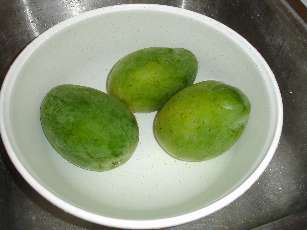 Step 4 -Wash the mangoes!
Step 4 -Wash the mangoes!
I'm sure you can figure out how to wash the mangoes in plain cold or lukewarm water.
Step 5 - Peeling the Mangoes
Nope, we're not going to peel them strictly by hand; that's way too much work. Instead, here's a great trick that works with many fruits and vegetables with skins (like tomatoes): just dip the fruit in boiling water for 60 seconds. Remove from the water using a slotted spoon and put into a large bowl or pot of cold water and ice. The skins will easily peel off more easily now! Mangoes are also MUCH easier to peel when slightly ripe.
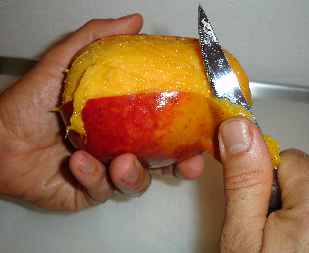
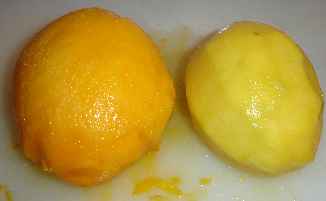
Step 6 - Cut up the mangoes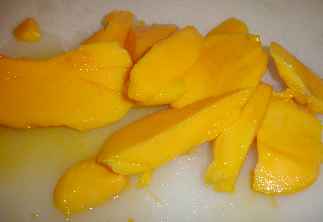
Cut out any brown spots and mushy areas. Slice the mangoes in 1/4 thick slices!
Step 7 - Mix the mangos with the solution or FruitFresh .
Use a bowl to mix mango slices with the syrup solution. If you are using a dry pack; use either a bowl or a large plastic bag (gallon size ZipLocs work well) to evenly coat the mango slices.
Step 8 - Pack the slices into your freezer containers
Pack the slices into your freezer containers (freezer bags or plastic freezer containers... or glass (but due to risk of breakage, I tend not to use glass in the freezer). If you are using the dry pack approach, the treated mango slices can also be frozen first on a tray and then packed into containers as soon as they are frozen.
Step 9 - Freeze!
That's it! They're done. If your freezer is good and cold (below 25 F) they should keep for many months. Try to avoid frost-free freezers, as they cycle briefly above freezing!
Looking for canning equipment and supplies?
Water bath canner with a jar rack
Pressure canners for gas, electric and induction stoves: Presto 23Qt or T-fal 22Qt
Canning scoop (this one is PERFECT)
Ball Blue book (most recent version)
Jars: 8oz canning jars for jams
Find Other types of farms:
Farm markets and roadside stands
Road trips and camping resources
Local Honey, apiaries, beekeepers
Consumer fraud and scams information
Home canning supplies at the best prices on the internet!
Maple Syrup Farms, sugarworks, maple syrup festivals
Environmental information and resources
Farms For Your Event for birthday parties, weddings, receptions, business meetings, retreats, etc.
Festivals - local fruit and vegetable festivals
Get the
most recent version of
the Ball Blue Book
With this Presto 23 quart pressure canner and pressure cooker, you can "can" everything, fruits, vegetables, jams, jellies, salsa, applesauce, pickles, even meats, soups, stews. Model 01781

You can make jams, jellies, can fruit, applesauce, salsa and pickles with water bath canners, like this Granite Ware 12-Piece Canner Kit, Jar Rack, Blancher, Colander and 5 piece Canning Tool Set

